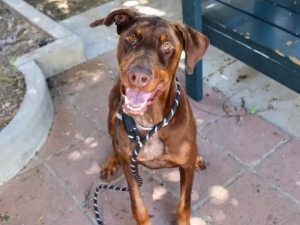Did you know that dog diversity is down to 1% of their DNA?

Hello, I’m Canelo (A509762), a sweet and friendly 2-year-old Doberman Pinscher in search of a loving new home. With my sleek red and tan coat and my goofy demeanor, I’m ready to win your heart over. If you’re seeking a loyal and affectionate companion who will bring joy and warmth to your life, I’m your guy! Plus, I’m available to a 10-day adoption trial.
If you spend a morning at the Del Mar dog beach, you will find it shocking that all dogs are descended from wolves.
Our family’s recent vacation in San Diego gave me newfound appreciation for pooch variety. Of course, I see many different types of dogs at the shelter every day. But rarely do I see so many dogs freely running, playing and sniffing together.
Open spaces where such a great number of canines congregate off-leash are hard to find (I remind you that it is illegal for dogs to run off-leash in our service areas). But I must admit, dogs’ varied physical traits and personalities really shine in an off-leash beach environment.
My new friend Walter, a French bulldog who roamed with a tennis ball firmly stuffed in his mouth at all times, loved to saunter over and sit on my feet whenever I encountered him on my walks. Sadly, but understandably, most dogs were more interested in other dogs than they were in me.
I saw the tiniest of toy fluffies and a huge dog that looked like it could be a cross between a mastiff and a horse. A lumbering basset hound was herded by a sheep dog, and every dog on the beach was outrun by my son’s whippet, Hugo. When Hugo reached a gallop as the other dogs chased behind, it was a beautiful sight to behold.
Let me be clear: I am a true fan of mixed breeds, who comprise roughly 50% of all dogs and 80% of dogs in shelters. I saw many mixed-breed dogs enjoying themselves immensely. I also talked to lots of people who had adopted their pets, which is the best!
Regardless of your position on adopt versus shop, we need to take a moment to appreciate canine diversity and to contemplate how this came to be. If you compare them to cats, for example, the difference among dogs is much larger.
So, how did the dog species evolve into animals as varied in size as a Chihuahua and a St. Bernard, and as different in personality and talents as a sleek Hugo and a chunky Walter?
Amazingly, dogs share 99.9% of their DNA with gray wolves, but that other 1% makes a huge difference. Natural and artificial selection of traits within that 1% have resulted in dogs having the most variety of any mammal.
It’s not clear when wolves started to turn into humans’ best friends, but scientists estimate it was between 15,000 and 40,000 years ago. Dogs were the first animal species domesticated by humans. People benefited from dogs’ hunting and guarding skills, and dogs benefited from being fed and cared for by humans.
Different breeds of dogs evolved naturally throughout the world over time. Archeological evidence indicates that about 9,000 years ago people began to breed dogs for specific purposes, such as pulling sleds.
Dogs have been bred for a multitude of jobs, from exterminating rats to sniffing out truffles. They’ve become indispensable in search and rescue, service and therapy work and bomb detection.
Of course, humans have come to rely on dogs for companionship. For centuries, pups have been bred to be lapdogs, and more recently, “designer dogs” have been cross-bred to provide hypoallergenic companionship in a variety of shapes and sizes.
So, the next time you look at a dog, try to think of the path it took from wolf to what it is today. For some dogs like huskies and shepherds, it’s not as big a leap to imagine. But for others, the transformation is miraculous.
To see a variety of dogs available for adoption this Labor Day holiday weekend, stop by Pasadena Humane’s visiting hours 2-5 p.m. Sept. 3-4, at 361 S. Raymond Ave., Pasadena.
Dia DuVernet is president and CEO of Pasadena Humane.
This blog post originally appeared as a column in the Pasadena Star-News on September 5, 2023.


